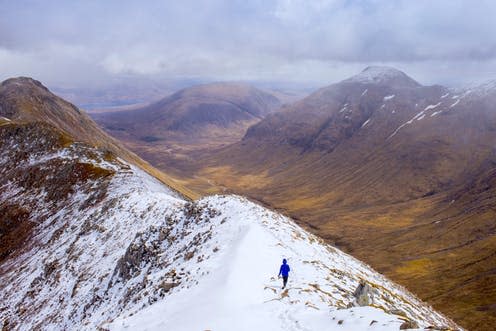Climbing Scottish mountains: why 'munro-bagging' is on the up and up

Start climbing a Scottish mountain and you’re bound to pass some “Munro-baggers” on your way to the top. These keen walkers have set themselves the formidable challenge of reaching the summit of each of the 282 Munros – Scottish mountains of 3,000 feet and above. Many hikers take a lifetime of weather windows and stolen weekends to “compleat a round” to become a “Munroist”. Others do it in mere months – or even embellish the challenge by performing continuous, solo or winter rounds.
Munro-baggers are scorned by some purists who argue that basing walking days on measurements that are inevitably somewhat arbitrary is incongruous with enjoying the beauty of the Scottish mountains. What blinkered folly, the logic goes, to drive past sub-Munro gems such as The Cobbler, Suilven and Stac Pollaidh to reach land of greater height but often lesser character.
Undeterred, there seem to be increasing numbers working on their lists of Munro summits – albeit the exact popularity of this past-time is not entirely clear. Most new Munroists report their achievement to the Scottish Mountaineering Club, whose official log of 200-250 annual “compleators” is not much different to, say, a decade ago.
Yet roadside laybys and hills have never looked busier – and burgeoning social media communities are emerging. Either more people are attempting the challenge but not doing all 282, or new Munroist numbers will rise in years to come. Sir Hugh Munro, the mountain enthusiast who gave his name to these summits, would surely be delighted. With the centenary of his death just weeks away, why are so many climbing mountains?
181 down, 101 to go
Half of our research team is 18 years into a sporadic bagging career which has yielded 181 summits, which is handy for meeting enthusiasts and having a degree of empathy and insiderness. We have spoken with hundreds of walkers “on the hill”, interviewed dozens more off-site, and observed their posts, comments and interactions online. Our findings suggest that six key factors are driving Munro-bagging to new heights.
The first two factors are unsurprising: austerity and the weak pound. After a decade of squeezed disposable incomes, many UK residents are valuing staycations and the relatively low costs of hillwalking (even if the likes of fuel and hiking gear still add up). As most Scots live within an hour’s drive of the Highlands, Munro-bagging is often achievable by day-trip, making it possible to cherry-pick sunny weather, sleep in your own bed and let aching muscles recuperate. But while 66% of Munroists live in Scotland, favourable exchange rates are also enticing overseas visitors – the Highlands are already a favoured destination for German and Dutch tourists, for instance.
The third factor is the Scottish government, which has done much to nurture tourism by marketing the country heavily in the UK, western Europe and countries with deep Scottish ancestries such as Australia, Canada, the US and New Zealand. Initiatives such as the North Coast 500 road route and a flourishing network of long-distance footpaths have introduced new visitors to the Highlands and produced a “halo effect” around mountain-based activities.
There has also been a noticeable shift in societal attitudes towards women’s leisure. Many women used to be prevented by lower average disposable incomes as well as masculine portrayals of adventure. They were also deterred by male-dominated bunkhouse dormitories and bothy huts – not to mention society’s disproportionate expectations around women “staying home and looking after the kids”.
Far less so nowadays, where a glance around the hills and social media sites suggests that women now comprise 30% to 40% of Munro-baggers. Although only around 23% of recent “compleators” have been women, the average Munro round lasts over 20 years, so demographic changes among Munroists will take years to catch up.
Social media is another important driver. Munro-baggers nowadays use everything from Facebook to Instagram to club messageboards to exchange advice, post photographs and reports, and generally joke, plan, debate and argue. This takes the hobby well beyond mountain days and helps to create a scene that draws in prospective new recruits.
Finally, there has been an undeniable surge in Scottish national pride since the 2014 independence referendum. Hillwalking websites abound with references to “our beautiful wee country” and summit selfies featuring the Scottish saltire flag. More and more Scots appear to be seeking a spiritual connection to a romanticised version of their land – and what better way than to head for unspoiled wilderness and scale some rugged mountains?
In short, Munro-bagging may not yet have, er, plateaued. There will always be those who just want to climb Ben Nevis and be the highest person in the land, or are blissfully ignorant of these mountains, even when standing on one. But Munro-baggers will keep journeying on, dreaming of that final summit and how they will celebrate it – a group of friends, maybe a piper, certainly a wee dram. There’s something uniquely addictive about getting to the top, as more and more people are realising with every year that goes by.
This article is republished from The Conversation under a Creative Commons license. Read the original article.

David M Brown is a dedicated munro-bagger.
Tom Mordue prefers fishing.

 Yahoo News
Yahoo News 


